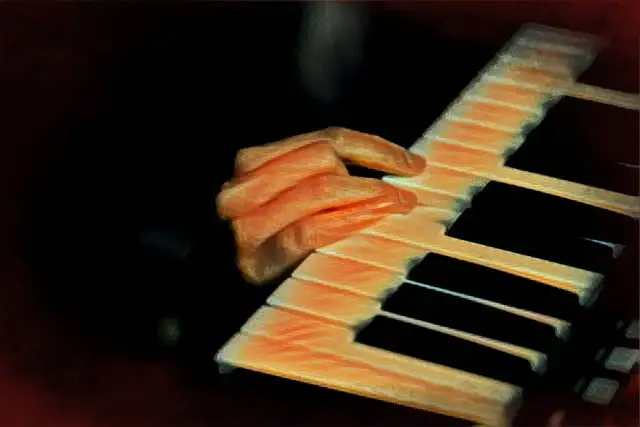MIDI controllers are the shizzle when it comes to music production.
From inputting MIDI notes to bashing out rhythms on the finger drums to controlling detailed nuances of your production, MIDI controllers can help you do it all.
And a 49 key MIDI keyboard is a good size to have. It's big enough to play moderately complex parts on while taking up only a tiny amount of real estate on your desk. And it's portable enough to take out on tour if that's your thing.
Here at eMastered, we've put together a comprehensive list of the leading controllers on the market, to help you choose the best 49 key MIDI controller for your playing style.
The Top Ten 49 Key MIDI Controllers
1. Best For The Budget: M-Audio Keystation 49 MkIII

Quick Look
- 49 synth-action keys
- Volume fader
- Transport & directional controls
- Sustain pedal input
M-Audio is a name synonymous with keyboard controllers, and the M-Audio Keystation 49 kicks off our list as the best 49 key midi controller for budget-conscious musicians.
This USB MIDI keyboard boasts 49 full-size, velocity-sensitive keys. As you'd expect at this price, they're not weighted in any way but the action is decent nonetheless. Apparently, they can withstand a toddler bashing away at them, so they're durable too!
There's a small handful of basic controls on the keyboard to expand your inspiration. The pitch and modulation wheels lie to the left of the keybed, and above them is a single volume fader. This can be assigned to any MIDI parameter, giving you deeper control over your plugins.
Next to the fader are some basic transport controls (stop, play, and record), and above it are four directional buttons (up, down, left, right). These can be used to control any recording software.
The mysterious 'advanced' button augments all faders, wheels, and buttons so they can be assigned to any DAW of plugin parameters.
Around the back of the keyboard is an on/off switch, a 1/4" pedal input, and the USB Type B port.
It's worth noting that the Keystation 49 is iOS compatible, so (if you shell out for the iPad Camera Connection Kit) you can use it to jam on software instruments on your iPad. Be warned that this will drain your iPad battery pretty darn quickly though!
The Keystation comes with a healthy software bundle, including Ableton Live Lite, MPC Beats, and a selection of instruments from Air Music Tech. Certainly, enough for the beginner to start making music right out of the box.
The simple design and minimal controls of the Keystation mean it's a great choice for beginners, or folks with limited studio space. And weighing in at just under 5lbs, it's also a great choice for the touring musician.
Why Buy
- Budget-friendly
- Simple, streamlined controls
- iPad compatible
2. Best For Key Action: Roland A-49

Quick Look
- Full-size, synth-action keys, with rounded edges
- 2 knobs, 2 switches
- Pitch/modulation lever, plus D-Beam controller, for inspired creative expression
- 5-pin MIDI out connection
- Sustain and expression pedal inputs
The Roland A-49 is another simple 49 key MIDI controller, with very few bells and whistles.
Designed for the discerning player, the synth-action keys sit on a great-feeling keybed, and have contoured edges to make playing a more comfortable experience.
If you have no idea what I'm talking about, try doing multiple glissandos a night on a square-edged keyboard, and you'll soon understand. (The pain! The blood!).
Roland have also put some effort into reducing the keybed noise on this board - say goodbye to annoying clunks that interfere with your performance.
In another tip of the hat towards live work, the A-49 has two footswitch inputs - one each for sustain and expression. It also has a 5-pin MIDI out port for controlling external synths. Be aware that it doesn't come with an external power supply, so you'll still need a device to plug into.
There are only a handful of features on this slimline MIDI keyboard. The famed Roland pitch/mod lever may take some getting used to if you're used to separate wheels for each, but the D-Beam controller is super-fun to use, especially in live situations.
Octave up/down, and transpose buttons give you easy access to the full range of a piano, with LED indicators letting you know how far you've moved.
Beyond these, there are two buttons, and two knobs, all of which are assignable. You may need to dive deep into the manual to figure out how to control your third-party software instruments with them though.
But if you're a user of Roland external hardware, or soft synths via Roland Cloud, the A-49 offers onboard control of Roland SuperNATURAL-powered synths.
The A-49 is iOS compatible, so you can access their massive Roland Cloud library from your iPad and play them directly from the keyboard. Roland claims the A-49 draws minimal current through USB MIDI, making it a smart choice for using with an iPad.
One thing worth noting about installation - it's not classic plug-and-play (at least for Mac users). Make sure you head to the Roland website to download the latest version of the software before using it!
Why Buy
- Great keybed action
- Lightweight, with simple controls
- Multiple pedal ports, plus MIDI out, make it ideal for live performance
3. Best For Use With NKS Software: Native Instruments Komplete Kontrol S49

Quick Look
- Semi-weighted Fatar keybed with smooth action and response
- 8 touch-sensitive knobs, 4-directional push controller
- Dedicated transport control (DAW dependent)
- 2 x footswitch sockets
- MIDI In/Out
- Pitch bend & mod wheels, touch strip controller
For musicians who either have already dived into the extensive sound world of Native Instruments or for those who are interested in doing so, the S49 keyboard controller from Native Instruments is a solid choice for a 49-key keyboard.
The S-series of NI controllers come with a Fatar keybed, which gives a smooth response and should satisfy even the most demanding of players. The semi-weighted keys are responsive enough to handle widdly synth lines, as well as giving enough resistance to lay into expressive piano parts.
Included on the keyboard are a set of controls designed to operate your DAWs transport features.
Be warned - the S49 currently only supports six DAWs (Logic, Ableton, Garageband, Studio One, Cubase, and Nuendo). So if you're name's not on the list, it's probably better to move on to one of the many other MIDI controllers on this list.
Where the S49 keyboard really shines is with the seamless integration with NI's own Komplete Collection and other NKS-enabled software.
Using the 4-directional controller you can call up individual instruments, or browse presets, searching by descriptive keywords to help you find exactly the sound you need.
Once you've dialed up the sound, the touch-sensitive control knobs are automatically mapped to the instrument, allowing you to tweak the sound to your heart's content.
If you use any third-party software that isn't NKS compatible it's easy enough to create your own mappings for these controllers from the Komplete Kontrol software.
Two-color displays show what you're working on, so you know at a glance what parameters you're changing, or what sounds you're working with.
Other features onboard the S49 include smart chord and smart key functions, and an onboard arpeggiator.
For musicians with outboard gear, there are MIDI in and out connections, plus sustain and expression pedal inputs for additional control over your playing.
And if you are a fan of Maschine, the S49 will work smoothly side by side with any Maschine hardware.
Finally, if you're not yet immersed in the Komplete Collection, the software bundle that comes with the S49 is designed to offer an easy (and affordable) entry point into the Komplete world. (Yes, I'm aware that sounds a little bit cultish).
Once you've tried out the Komplete Select package that comes with the keyboard you can choose a discounted upgrade path that suits your needs.
All in all, the S49 is a solid MIDI controller for music production centered around NI sounds
Why Buy
- Seamless integration with NKS-enabled software
- On board, tag-based sound browsing
- Great feeling keybed
4. Best for Touring: Arturia Keylab 49 MKII
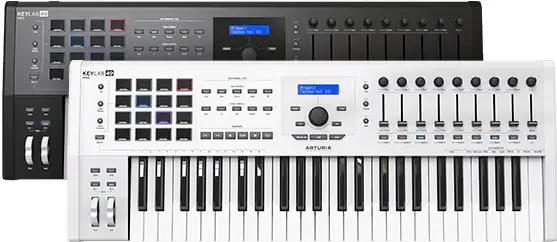
Quick Look
- 49 semi-weighted, velocity-sensitive keys, with aftertouch
- 16 backlit drum pads
- 9 faders, 9 assignable knobs
- Dedicated DAW controls
- 5 pedal inputs, 5 CV connections
- MIDI In/Out
The Keylab 49 MkII from Arturia is an impressive MIDI controller, boasting a full collection of controls, plus extensive in/out connections for hooking up an external gear. On top of all that, you get access to over 6,000 synth and keyboard sounds from the company's award-winning V-collection.
The aluminum chassis is lightweight, yet sturdy enough to handle touring duties. The keybed delivers a professional feel and has the advantage of aftertouch - perfect for adding variation to sounds while playing with two hands.
And if you have a hand free, it won't be short of things to fiddle with. The collection of performance pads, faders, and knobs gives you complete control over any virtual instrument, and the transport buttons allow you to control your DAW right from the keyboard.
Speaking of which, the Arturia Keylab comes with DAW-specific magnetic overlays to help you navigate around the controls. A nice touch, and handy if you switch between DAWs regularly.
Around the back of the keyboard, there's plenty going on too. A total of 5 pedal inputs - sustain, expression, and 3 aux - gives you plenty of opportunity for modulating your performance with your feet. In addition, there are 5-pin MIDI In/Out connections, and CV output jacks - a rare sight indeed on MIDI keyboards.
If all these external connections seem like overkill, consider Keylab Essential. It has fewer controllers on the main board, but essentially (see what I did there?) does the same job.
Be warned that the Keylab 49 key controller is advanced; there'll be a learning curve involved in getting to grips with how everything works. But once you've mastered it, you'll have deep control over all your software and hardware synths.
Why Buy
- Sturdy & rugged build quality ideal for touring
- Comes with a large selection of classic vintage synth sounds in software form
- An impressive array of I/O connectivity
5. Best For DAW Control: Nektar Impakt LX49
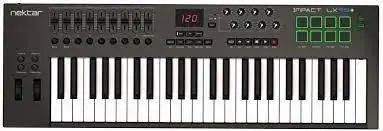
Quick Look
- Synth-action, velocity-sensitive keys
- 8 RGB pads, with 4 banks
- 9 buttons, 9 faders, 8 knobs
- DAW controls are compatible with most major software
- LED screen for parameter feedback
Whether you're a newbie to the world of MIDI controllers, or a seasoned pro looking for a gear upgrade that comes without a learning curve, the Nektar Impact LX 49 key MIDI controller is a stellar choice.
With 49 velocity-sensitive keys, and a healthy selection of buttons, faders, and pads, the Impact allows you to control your DAW and virtual instruments with ease, while at the same time using an inconspicuous amount of desk real estate.
The semi-weighted keys are adequate enough for most keyboard/programming parts. At this price point, and with the number of controls, you could hardly expect the feel of a Nord. What Impact excels at is the plug-and-almost-play simplicity of its integration.
Once you get the keyboard, you create an account on the Nektar website, choose your DAW, and download a small installation file. And then you're up and running. Note that some DAWs, including Pro Tools, require a little finagling to get the hardware and software talking to each other.
And if the layout doesn't suit your workflow, it's easy enough to reconfigure the assignable knobs, buttons, and faders to a style that suits you, and save them as one of five users presets.
Programming any of the buttons or knobs is easy using your DAWs learn mode. Settings are stored over the power cycle but do get lost if you switch presets, so if you find a configuration you like be sure to save it.
The pads also deserve an honorable mention. They feel great, are super-responsive, and also double up as scene marker controllers or clip launchers in Ableton.
Overall, this is a simple bit of kit to use, but versatile enough to satisfy even the most demanding producer.
Why Buy
- Excellent DAW and software integration
- Ideal for anyone new to MIDI controllers
- Lots of control options for the budget-conscious
6. Best For Ableton Users: Novation Launchkey 49

Quick Look
- 49 velocity-sensitive, synth-action keys
- 16 RGB backlit pads
- 8 assignable knobs, 9 faders
- MIDI out socket
The Novation Launchkey series is a set of MIDI controllers aimed specifically at Ableton users.
That said, many users of other DAWs have found this 49-key controller to be a joy to work with since it has full integration with Logic, Cubase, and Reason.
And while it ships with this integration ready to go, you can use one of the four Custom Modes to make the Launchkey 49 your own.
Aside from the profusion of knobs, buttons, and faders, what other features does this keyboard offer?
For music production, I think the most exciting ones are the Scale Modes, Chord Modes, and arpeggiator features. These tools allow you to bypass years of music theory training (grrr, although I don't regret it) and focus on creating the music. The arpeggiator's mutate function takes your patterns, and as you may have guessed from the name, modifies them to create new ideas.
If you're using outboard synths, the Launchkey can work in standalone mode via the 5-pin MIDI out connection. Assign the knobs, faders, and pads to hardware features using the browser-based Novation Components tool, and raise your live sets to a new level.
If the number of keys isn't enough for you, there's also an 88-key version of the Launchkey. And yes, they both come with a copy of Ableton Live Lite, in case you were wondering.
Why Buy
- Optimized for Ableton Live
- Works in standalone mode too - can be programmed to control an all-hardware live rig
7. Best For Pads: Akai Professional MPK249
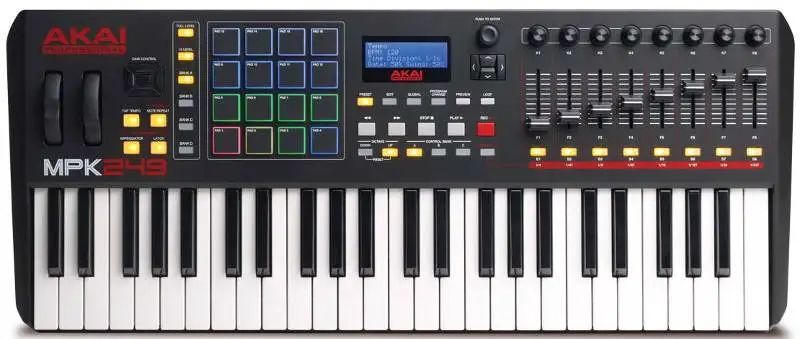
Quick Look
- Full-size, semi-weighted keybed with aftertouch
- 16 RGB illuminated MPC pads
- 8 knobs, faders, and switches
- MIDI In/Out
- Sustain and expression pedal inputs
- Detail-oriented transport and parameter controls
- Backlit LCD screen for parameter feedback
- Optional external power supply
If you want pads, the Akai MPK249 has them. 16 physical ones, with 4 banks of each, giving you a plentiful 64 pads that can be assigned at will.
What's more, they're the real-deal MPC pads you'll find on classic Akai MPC hardware.
But what other features does the Akai Professional MPK249 has to offer, besides pads?
For starters, the 49 keys are aftertouch enabled - perfect for adding depth to a two-handed performance without having to overdub control data.
And when you want to dive deeper into sound design there are 8 assignable knobs, faders, and switches, each with three banks. These are responsive to MIDI learn features found on most DAWs and virtual instruments.
A set of transport controls sits in the middle of the controller, and there's no need to download any templates to get the MIDI controller talking to your DAW. On this note, some users have experienced problematic USB3 connections; this can be fixed by using a different USB cable.
Boost your creativity with features from classic MPC hardware of yore: MPC Swing, MPC Note Repeat, and Full Level are all available to inject some flourish into your music production. The arpeggiator has a comprehensive set of tools to help you explore and develop your musical ideas.
On the software side, you get a copy of MPC Essentials (which can also be used as a plugin in your favorite production software and Ableton Live Lite. Virtual synths include the rather juicy Hybrid 3 from AIR Music Technology, and SONiVOX Twist 2.0, a spectral morphing synth.
One thing worth noting is that the Akai MPK249 is a little heavy. Weighing in at a little over 12lbs, it's not exactly a back-breaker, but if portability is your thing check out the next keyboard.
Why Buy
- Akai has years of experience in the industry
- Use genuine MPC production workflow features in your tracks
- VIP software allows users to combine plugins and effects into new multi-timbral textures
8. Best For Portability: M-Audio Oxygen Pro 49

Quick Look
- 49 Key semi-weighted MIDI controller
- 16 RGB velocity-sensitive drum pads
- 9 faders, 8 assignable knobs
- Dedicated transport controls
- Smart Chord & Smart Scale features
- Sustain pedal input
- 5-pin MIDI out connection
The Oxygen Pro49 from M-Audio is built with the modern producer in mind. Designed with feedback from artists, it fits right into your production process wherever you're making music.
From the pitch bend and modulation wheels to the full-size, velocity-sensitive keys, everything feels great to play on this MIDI controller. The semi-weighted keys are aftertouch enabled to give the player added expression possibilities.
The RGB drum pads come with a Note Repeat function, essential for producing hip hop, electronic, and dance music.
The Smart Chord and Smart Play features reduce any limitations stemming from your knowledge of music theory, and you can further augment your creativity using the onboard arpeggiator to trigger any virtual instrument.
For me, the Oxygen Pro is the best 49 key midi controller for folks who move from studio to studio and need a comprehensive set of controls to take with them.
Why Buy
- Lightweight MIDI controller, with a full set of controls
- Preset and DAW buttons for auto-mapped controllers
- Cost-effective portability
9. Best For Playable Simplicity: Alesis V49 MKII MIDI Controller

Quick Look
- Full-size piano style, synth-action keys
- 8 drum pads, 4 assignable knobs, and buttons
- Onboard arpeggiator
- Pitch bend and modulation wheels
If all these pads and controllers are sending your brain into a spin, the Alesis V49 will calm your nerves, while giving you creative solutions to your music production voyages.
This simple 49-key controller has 8 pads, 4 knobs, plus the usual octave and transpose buttons, and pitch and modulation wheels.
The pads can make use of the not repeat or full level features, to make programming beats feel like you're working on a classic drum machine.
The onboard arpeggiator has six modes to experiment with, plus tap tempo, time division, gate, and swing controls.
Four buttons and knobs can all be assigned to MIDI control. Making use of your DAW or software instrument MIDI learn feature is the simplest way of doing this. Braver users can download the V49 editor to make detailed parameter mapping, and save it as a preset for future use.
Considering the price of the V49, the build quality is pretty decent. Some users complain about the velocity curve of the keyboard, but this can be adjusted if it doesn't suit your playing style. There have in the past been issues with the drum pads, so make sure you download the firmware update!
Why Buy
- Affordable, and simple to use
- Slim design fits into a smaller studio set-up
- Enough features to give the user control, without being overly complicated
10. Best For Onboard Sounds: Yamaha MX49V2
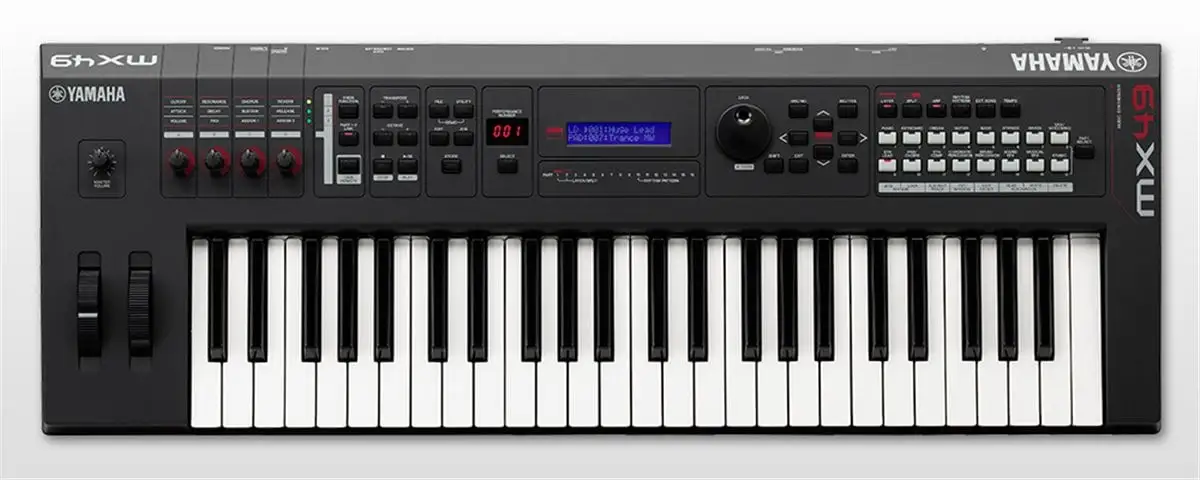
Quick Look
- Full size, synth-action, velocity-sensitive keys
- USB Audio/MIDI interface
- MIDI In/Out
- 2 pedal inputs
- Over 1,000 onboard sounds and effects
- DAW/virtual instrument controls
This last keyboard is unlike the other 49 key controllers we've looked at, in that it comes with a massive library of onboard sounds.
That kind of goes against the grain of MIDI controller keyboards - they're designed to control sounds in the box. So why include the Yamaha on this list?
Sometimes a player wants on-stage sounds without having to carry around an additional device, like a laptop or iPad. But at the same time, they want simple control over a studio recording setup.
Enter the Yamaha. With its library of sounds based on the Motif XS soundbank, you'll have everything from organic, real-world instruments, to synth-based textures for modern productions.
And when you're ready for recording the plug-and-play USB Midi connectivity will integrate seamlessly with your DAW, allowing you to record sounds directly from the MX. Or use the keyboard as a 'traditional' MIDI controller, playing virtual instruments.
The DAW remote section can control transport, mixer, and software instruments right from the top panel of the MX 49.
To top it all off, the MX49 functions as its own audio interface. You can monitor the output of your DAW right from the keyboard - either through headphones or by connecting monitors to the L/R output jacks.
True, this 49 key MIDI controller is not typical among its peers. But it's a versatile solution for the musician who spends their afternoons in sessions, and their evenings on stage.
Why Buy
- Perfect for simple control in the studio, and ready-to-go sounds on stage
- Flagship Motif XS sound bank and modeled vintage effects
What To Look For In A Keyboard Controller
When you're choosing a controller for your studio or live rig, there are a few things you'll want to chew over before making a decision.
When you're reading through this, rank which factors are important for you to help you decide on the keyboard of your dreams.
Keybed Feel
Not all 49 key midi controller keyboards are made equal - some will have synth-action keys, and others are semi-weighted.
You'll not be able to get 49 fully weighted keys, but you can get 'piano style' if you're willing to shell out a little more.
External Connectivity
Aside from a USB cable to connect to your PC or Mac, what other connections will you need? If you want to control external gear, you'll need a MIDI out connection.
If that gear is also sending information to your DAW you'll also need a MIDI in the socket.
And don't forget your feet! At minimum, you'll want a sustain pedal input (you're in luck - all these boards have one).
But if you like controlling expression while playing with both hands, you'll need an additional (assignable) footswitch input on your MIDI controller.
DAW Compatibility
Some keyboards play nicer with some DAWs than others, and some are designed specifically with one DAW in mind. So make sure the keyboard you choose is compatible with any DAW(s) you use.
Number & Type Of Controllers
Some people love to have a ton of buttons, knobs, and faders to jiggle around as they make music. Some people just want a few pads to knock out beats on. And some need the simplicity and want the (fake) ivories alone, so they can play in MIDI parts, and nothing else.
Think about how you make music and your workflow when choosing what controllers to have on your keyboard. But bear in mind that controllers are creative tools, and you may find yourself being more productive as you play with tools you've previously not utilized.
Durability
If you're planning on taking your keyboard out on tour, you'll need something that's built to withstand the rigors of the road.
Budget
Ah yes, Mr. Money has made an appearance. After weighing all these factors up, you'll also need to consider how much dosh you have to lay out on your keyboard.
Luckily, there's something for everyone on this list no matter what your budget.


